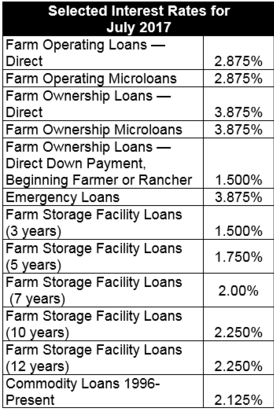|
 County
Committees are unique to FSA and allow producers to have a voice
on federal farm program implementation at the local level. County
Committees are unique to FSA and allow producers to have a voice
on federal farm program implementation at the local level.
To be
eligible to serve on the FSA county committee, a person must
participate or cooperate in an agency administered program, be
eligible to vote in a county committee election and reside in
the Local Administrative Area (LAA) where they are
nominated. All producers, including women, minority and
beginning farmers and ranchers are encouraged to participate in
the nomination and election process.
Producers may nominate themselves or others as candidates.
Organizations representing minority and women farmers and
ranchers may also nominate candidates. To become a nominee,
eligible individuals must sign form FSA-669A. The form and more
information about county committee elections is available online
at: www.fsa.usda.
gov/elections.

Elected county committee members serve a three-year term and are
responsible for making decisions on FSA disaster, conservation,
commodity and price support programs, as well as other important
federal farm program issues. County committees consist of three
members.
FSA
will mail election ballots to eligible voters beginning Nov.
6. Ballots are due back in the the County Office
by mail or in person no later than Dec.
4. All newly elected county committee members and
alternates will take office January
1, 2018.
For
more information about county committees, please contact your
County FSA office or visit www.fsa.usda.
gov/elections.
Producers on farms with base acres under the safety net programs
established by the 2014 Farm Bill, known as the Agriculture Risk
Coverage (ARC) or Price Loss Coverage (PLC) programs, can visit
their local FSA office to sign contracts and enroll for the 2017
crop year. The enrollment period will continue until Aug.
1, 2017.
Since
shares and ownership of a farm can change year-to-year,
producers on the farm must enroll by signing a contract each
program year.
If a
farm is not enrolled during the 2017 enrollment period, the
producers on that farm will not be eligible for financial
assistance from the ARC or PLC programs for the 2017 crop should
crop prices or farm revenues fall below the historical price or
revenue benchmarks established by the program. Producers who
made their elections in 2015 must still enroll during the 2017
enrollment period.
The
ARC and PLC programs were authorized by the 2014 Farm Bill and
offer a safety net to agricultural producers when there is a
substantial drop in prices or revenues for covered commodities.
Covered commodities include barley, canola, large and small
chickpeas, corn, crambe, flaxseed, grain sorghum, lentils,
mustard seed, oats, peanuts, dry peas, rapeseed, long grain
rice, medium grain rice (which includes short grain and sweet
rice), safflower seed, sesame, soybeans, sunflower seed and
wheat. Upland cotton is no longer a covered commodity. For more
details regarding these programs, go to www.fsa.usda.gov/arc-plc.

For
more information, producers are encouraged to visit their local
FSA office. To find a local FSA office, visit
http://offices.usda.gov.
New
operators or owners who pick up a farm after the acreage
reporting deadline has passed and the crop has already been
reported on the farm, have 30 days to change the intended use.
Producer share interest changes alone will not allow for
revisions to intended use after the acreage reporting date. The
revision must be performed by either the acreage reporting date
or within 30 calendar days from the date when the new operator
or owner acquired the lease on land, control of the land or
ownership and new producer crop share interest in the previously
reported crop acreage. Under this policy, appropriate
documentation must be provided to the County Committee’s
satisfaction to determine that a legitimate operator or
ownership and producer crop share interest change occurred to
permit the revision.
FSA
guaranteed loans allow lenders to provide agricultural credit to
farmers who do not meet the lender's normal underwriting
criteria. Farmers and ranchers apply for a guaranteed loan
through a lender, and the lender arranges for the guarantee.
FSA can guarantee up to 95 percent of the loss of principal and
interest on a loan. Guaranteed loans can be used for both farm
ownership and operating purposes.
Guaranteed farm ownership loans can be used to purchase
farmland, construct or repair buildings, develop farmland to
promote soil and water conservation or to refinance debt.
Guaranteed operating loans can be used to purchase livestock,
farm equipment, feed, seed, fuel, farm chemicals, insurance and
other operating expenses.
FSA
can guarantee farm ownership and operating loans up to
$1,399,000. Repayment terms vary depending on the type of loan,
collateral and the producer's ability to repay the loan.
Operating loans are normally repaid within
seven years and farm ownership loans are not to
exceed 40 years.

Please
contact your lender or local FSA farm loan office for more
information on guaranteed loans.
Farm
Service Agency (FSA) Farm Loan programs are considered
supervised credit. Unlike loans from a commercial lender, FSA
loans are intended to be temporary in nature. Therefore, it is
our goal to help you graduate to commercial credit, and our farm
loan staff is available to help borrowers through training and
credit counseling.
The
FSA team will help borrowers identify their goals to ensure
financial success. Through this process, FSA staff will advise
borrowers in developing strategies and a plan to meet your
operation’s goals and graduate to commercial credit. Ultimately,
the borrower is responsible for the success of the farming
operation, but FSA’s staff will help in an advisory role to
provide the tools necessary to help you achieve your operational
goals and manage your finances.
For
more information on FSA farm loan programs, visit www.fsa.usda.gov.
All
participants of FSA programs who request program benefits are
required to submit a completed CCC-902 Farming Operation Plan
and CCC-941 Average Adjusted Gross Income (AGI) Certification
and Consent to Disclosure of Tax Information to be considered
for payment eligibility and payment limitation applicable for
program benefits.
Participants are not required to annually submit new CCC-902s
for payment eligibility and payment limitation purposes unless a
change in the farming operation occurs that may affect the
determination of record. A valid CCC-902 filed by the
participant is considered to be a continuous certification used
for all payment eligibility and payment limitation
determinations applicable for the program benefits requested.

Participants are responsible for ensuring all CCC-902 and
CCC-941 and related forms on file in the county office are
correct at all times. Participants are required to timely
notify the county office of any changes in the farming operation
that may affect the determination of record by filing a new or
updated CCC-902 as applicable.
Changes that may require a NEW determination include, but are
not limited to, a change of:
-
Shares of a contract, which may reflect:
-
A land lease from cash rent to share rent
-
A land lease from share rent to cash rent
(subject to the cash rent tenant rule)
-
A modification of a variable/fixed
bushel-rent arrangement
-
The size of the producer’s farming operation
by the addition or reduction of cropland that may affect the
application of a cropland factor
-
The structure of the farming operation,
including any change to a member's share
-
The contribution of farm inputs of capital,
land, equipment, active personal labor, and/or active
personal management
-
Farming interests not previously disclosed on
CCC-902 including the farming interests of a spouse or minor
child
-
Financial status that may affect the 3-year
average for the determination of average AGI or other
changes that affects eligibility under the average adjusted
gross income limitations.
Participants are encouraged to file or review these forms within
the deadlines established for each applicable program for which
program benefits are being requested.
The
Internet allows you, the customer, access to USDA information 24
hours a day, seven days a week. You can fill out and submit
electronic forms (eForms) any time of the day or night from
anywhere you have Internet access. This new service delivery
option allows you to complete and file your own forms or
applications online, because your signature is already
electronically "on file."

Information submitted to the Federal Government remains safe and
secure because every customer has a unique User ID and password;
only authorized USDA employees can access your information. It's
safe, saves paper, saves a visit to your local USDA Service
Center and provides electronic tracking of all your USDA
transactions.
How
to Sign Up for eAuth:
Begin
the process by reviewing the information at the USDA Website
https://www.eauth.usda.gov.
This website describes the services available for Level 1 and
Level 2 Accounts.
Level
1 and Level 2 accounts require that you have an email address so
you can register, create a customer profile, and be able to
respond to a confirmation email.
Level
1 Accounts do not require you to provide proof of your identity
at a local USDA Service Center. Level 1 Accounts provide
limited access to certain USDA Web site portals that require no
authentication or authorization.
A
Level 2 Account does require a visit to a USDA Service Center
with proof of your identity. That is because a Level 2 account
allows you access to complete and submit documents and forms
electronically.
LEVEL 1 ACCOUNT
STEP
1. To obtain a Level 1 Account, you may self-register online at www.eauth.egov.usda.gov.
Scroll
down and click on the button that says “Sign Up for a Level 1
Account.” Complete the brief customer profile.
STEP
2. You will receive a confirmation email, and you must respond
to it within
7 days to activate your account.
LEVEL 2 ACCOUNT
STEP
1. To obtain a Level 2 Account, you must complete an 18 question
customer profile and prove your identity by presenting state or
federal photo ID at a local USDA Service Center. Go to
www.eauth.egov.usda.gov,
scroll down and click on “Sign Up for a Level 2 Account.”
Complete your customer profile, which includes designating your
user ID and password created by you, contact information and
email information. The data you enter in your customer profile
must match the data on the document you use as identification at
your local USDA Service Center. Example: Your first and last
names and address must match the government-issued photo ID you
plan to use to prove your identity. Identify proof can only be
verified by one of the following documents: Current State
Driver’s License, State Photo ID, US Military ID, or United
States Passport.
[to top of second column] |

STEP 2.
After completing your customer profile and submitting it online, you
will receive a confirmation email, and you must respond to it within
7 days to activate your account.
STEP 3.
Then you must complete the “Identify Proofing” process by visiting a
local USDA Service Center. You will be required to present the
eligible photo ID to an USDA employee who will verify your identity
and enter the expiration date of the ID document used.
STEP 4.
The USDA employee then will update your customer profile to a Level
2 Account. You will have access to USDA online applications and
forms within
one hour of your account being updated.
You now
have access to complete and submit documents and forms
electronically. USDA continues to update and make more forms and
programs available electronically.
FSA’s Farm
Storage Facility Loan (FSFL) program provides low-interest financing
to producers to build or upgrade storage facilities and to purchase
portable (new or used) structures, equipment and storage and
handling trucks.
The
low-interest funds can be used to build or upgrade permanent
facilities to store commodities. Eligible commodities include corn,
grain sorghum, rice, soybeans, oats, peanuts, wheat, barley, minor
oilseeds harvested as whole grain, pulse crops (lentils, chickpeas
and dry peas), hay, honey, renewable biomass, fruits, nuts and
vegetables for cold storage facilities, floriculture, hops, maple
sap, rye, milk, cheese, butter, yogurt, meat and poultry
(unprocessed), eggs, and aquaculture (excluding systems that
maintain live animals through uptake and discharge of water).
Qualified facilities include grain bins, hay barns and cold storage
facilities for eligible commodities.

Loans up
to $50,000 can be secured by a promissory note/security agreement
and loans between $50,000 and $100,000 may require additional
security. Loans exceeding $100,000 require additional security.
Producers
do not need to demonstrate the lack of commercial credit
availability to apply. The loans are designed to assist a diverse
range of farming operations, including small and mid-sized
businesses, new farmers, operations supplying local food and farmers
markets, non-traditional farm products, and underserved producers.
To learn
more about the FSA Farm Storage Facility Loan, visit www.fsa.
usda.gov/pricesupport or contact your local FSA county
office. To find your local FSA county office, visit
http://offices.usda.gov.
ELAP provides
emergency relief for losses due to feed or water shortages, disease,
adverse weather, or other conditions, which are not adequately
addressed by other disaster programs.
ELAP
covers physically damaged or destroyed livestock feed that was
purchased or mechanically harvested forage or feedstuffs intended
for use as feed for the producer's eligible livestock. In
order to be considered eligible, harvested forage must be baled.
Forage that is only cut, raked or windrowed is not eligible.
Producers must submit a notice of loss to their local FSA office
within 30 calendar days of when the loss is apparent.
For
beekeepers, ELAP covers beehive losses (the physical structure) in
instances where the hive has been destroyed by a natural disaster
including flooding, high winds, wildfire and tornadoes.
Producers
with a qualifying loss should contact their county FSA office to
file a notice of loss within 30 calendar days of when the loss is
apparent. Producers should also maintain records and receipts
documenting that livestock were removed from the grazing pasture due
to wildfire, costs of transporting livestock feed to eligible
livestock, receipts for equipment rental fees for hay lifts, feed
purchase receipts and the number of gallons of water transported to
livestock due to water shortages.
For more
information regarding ELAP, please contact your County FSA Office or
visitwww.fsa.usda.gov/disaster.

Agricultural producers are reminded to consult with FSA and NRCS
before breaking out new ground for production purposes as doing so
without prior authorization may put a producer’s federal farm
program benefits in jeopardy. This is especially true for land that
must meet Highly Erodible Land (HEL) and Wetland Conservation (WC)
provisions.
Producers
with HEL determined soils are required to apply tillage, crop
residue and rotational requirements as specified in their
conservation plan.
Producers
should notify FSA as a first point of contact prior to conducting
land clearing or drainage type projects to ensure the proposed
actions meet compliance criteria such as clearing any trees to
create new cropland, then these areas will need to be reviewed to
ensure such work will not risk your eligibility for benefits.
Landowners
and operators complete the form AD-1026 - Highly Erodible Land
Conservation (HELC) and Wetland Conservation (WC) Certification to
identify the proposed action and allow FSA to determine whether a
referral to Natural Resources Conservation Service (NRCS) for
further review is necessary.
Producers
who want to use the Noninsured Crop Disaster Assistance Program
(NAP) organic price and selected the "organic" option on their NAP
application must report their crops as organic.
When
certifying organic acres, the buffer zone acreage must be included
in the organic acreage.

Producers
must also provide a current organic plan, organic certificate or
documentation from a certifying agent indicating an organic plan is
in effect. Documentation must include:
-
name
of certified individuals
-
address
-
telephone number
-
effective date of certification
-
certificate number
-
list
of commodities certified
-
name
and address of certifying agent
-
a map
showing the specific location of each field of certified
organic, including the buffer zone acreage
Certification exemptions are available for producers whose annual
gross agricultural income from organic sales totals $5,000 or less.
Although exempt growers are not required to provide a written
certificate, they are still required to provide a map showing the
specific location of each field of certified organic, transitional
and buffer zone acreage.
For
questions about reporting organic crops, contact your local FSA
office. To find your local office, visit
http:// offices.usda.gov.
Bins are
ideally designed to hold a level volume of grain. When bins are
overfilled and grain is heaped up, airflow is hindered and the
chance of spoilage increases.
Producers
who take out marketing assistance loans and use the farm-stored
grain as collateral should remember that they are responsible for
maintaining the quality of the grain through the term of the loan.
If loan
grain has been disposed of through feeding, selling or any other
form of disposal without prior written authorization from the county
office staff, it is considered unauthorized disposition. The
financial penalties for unauthorized dispositions are severe and a
producer’s name will be placed on a loan violation list for a
two-year period. Always call before you haul any grain under loan.
Producers
enrolled in the Agriculture Risk Coverage (ARC) or Price Loss
Coverage (PLC) programs must protect all cropland and noncropland
acres on the farm from wind and water erosion and noxious weeds.
Producers who sign ARC county or individual contracts and PLC
contracts agree to effectively control noxious weeds on the farm
according to sound agricultural practices. If a producer fails to
take necessary actions to correct a maintenance problem on a farm
enrolled in ARC or PLC, the County Committee may elect to terminate
the contract for the program year.

Bins are
ideally designed to hold a level volume of grain. When bins are
overfilled and grain is heaped up, airflow is hindered and the
chance of spoilage increases.
Producers
who take out marketing assistance loans and use the farm-stored
grain as collateral should remember that they are responsible for
maintaining the quality of the grain through the term of the loan.


Illinois Farm Service Agency
3500 Wabash Ave.
Springfield, IL 62711
Phone: 217-241-6600
Fax: 885-800-1760
www.fsa.usda.gov/il
Acting State Executive Director:
Richard L. Graden

Acting State Committee:
Jill Appell-Chairperson
Brenda Hill-Member
Jerry Jimenez-Member
Joyce Matthews-Member
Gordon Stine-Member
Administrative Officer:
Dan Puccetti
Division Chiefs:
Doug Bailey
Jeff Koch
Randy Tillman
To find contact information for your local office go to
www.fsa.usda.gov/il USDA
is an equal opportunity provider, employer and lender. To file a
complaint of discrimination, write: USDA, Office of the Assistant
Secretary for Civil Rights, Office of Adjudication, 1400
Independence Ave., SW, Washington, DC 20250-9410 or call (866)
632-9992 (Toll-free Customer Service), (800) 877-8339 (Local or
Federal relay), (866) 377-8642 (Relay voice users). |